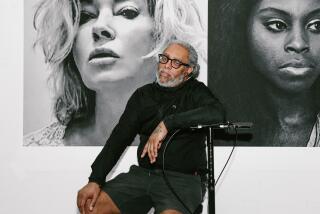DANCE REVIEW : ‘Toward the 21st Century’--Energetically : Dance: A festival of pieces by black choreographers underlines the contribution and continuing richness of this tradition.
- Share via
As a showcase for artists who gained national recognition during the past decade, “Black Choreographers Moving Toward the 21st Century” is a festival that reminds everyone how central people of color have been to the avant garde. That alone would make it an important event, and it’s only the beginning.
At the Wadsworth Theater (where performances continue through Sunday), there are eight companies--a slightly different lineup than the festival presented in San Francisco earlier this month. All of them have danced in Southern California before, but the new context encourages a major shift in audience perspective.
Guided by panels and program essays, we are invited to consider these artists less as firebrands of an evolving and often rootless postmodernism than as linked to black American cultural traditions. We are prodded to examine cross-cultural influences--on them, from them--and to think about the continuum between choreographers who just happen to be black and those exclusively involved with issues of black identity.
There’s much to learn, and unlearn, and sometimes the choreographers are no help at all, since they are absorbed in processes of art-making rather than supplying footnotes to somebody’s thesis. Not incidentally, the dominant theme of the four-part Thursday program was risk--from Dimensions Dance Theater venturing the technical hazards of a piece by Garth Fagan (and not really succeeding) to Bill T. Jones daring to abandon dance altogether and confront his mother with profound questions about suffering.
Set to taped pieces by Steve Reich and Abdullah Ibrahim, Fagan’s 1984 “Yesterday/Yesternow” alternated between small-scale, gestural motion and expansive, formal passages punctuated with propulsive jumps and sustained tests of balance. Dancers individualized by mime motifs (a scooping/reaching action, for example) were suddenly swept up in whole-body and then group statements. Later on, Fagan restructured these components in solos built on brilliant physical appositions.
This demanding style may be second nature by now to Fagan’s own company, but Oakland-based Dimensions is not yet in that league. Unisons frequently looked slovenly on Thursday, solos strained--though Anisa Rasheed as the lady in the tiger-striped top and Ian Vincent McGinnis in the “Man” variation worked diligently through their challenges.
Jones’ “Faith II: Work-in-Progress” began with him in the middle of the stage, his mother, Estella Jones, reading the Bible from a table on the right and then his sister, Flo Brown, singing gospel-style songs with Craig Brown at a microphone on the left.
His solo had the superb pliancy and deep passion of someone born and schooled for greatness, but soon he stopped dancing to speak his feelings about AIDS, homophobia (with a bitter reference to Eddie Murphy) and Christianity as “a religion of slaves.”
“I’m scared, momma,” he cried, and Estella Jones attempted to comfort him, repeating that “we’re living in the last days,” in a tormented world, and sharing her own early crisis of belief.
Was this extraordinary conversation planned as performance art, an act of public therapy or part of a workshop process? Ultimately it doesn’t matter. In making his pain a family affair and including us at the table, Bill T. Jones involved us in an act of trust that restored theater to its ancient role in communal healing.
John Pickett’s “Things Fall Apart” for the locally based Spotted Leopard Dance Company also traced an interior journey, as two nearly nude men (Pickett and Warren Lee) physicalized cycles of dependency and aggression keyed to the abrupt mood changes in a tape collage of music by John Zorn.
A program note mentioned the work’s origins in a novel about “the effects of colonialism on traditional Nigerian society,” but the work aimed for a dreamlike diffusion of image, incident and emotion, with its scrim lighting effects, billowing smoke and mysterious visitations by a ghostly Marina Panossian.
Unfortunately, the dream ended prematurely on Thursday, with the smoke inundating the theater, causing some audience members to move away from the stage, others to go home and still more to gamely cough through the end of the work. But, obviously the piece’s atmosphere and cumulative impact had been destroyed.
The celebratory crowd-pleaser of the program came from Jawole Willa Jo Zollar’s New York-based Urban Bush Women. Titled “I Don’t Know, but I’ve Been Told if You Keep on Dancin’ You’ll Never Grow Old,” it took ideas from American streets, schoolyards and stadiums, turning them into irrepressible group routines set to live vocal and percussion accompaniment.
Sometimes this tribute to “people who keep the spirit of dance alive all over the world” (Zollar’s words) merely looked like funky aerobics but other passages offered witty expansions of sports-movement or cheerleading ritual into dancing. However, the hyperkinetic seven-woman company proved consistently eclipsed by the resident music man, David Pleasant. Not only could he drum, sing, and play the harmonica, Pleasant launched a bravura patting-Juba display that left much of the audience deliriously slap-happy.
“Black Choreographers Moving Toward the 21st Century” continues tonight with works by Lula Washington, Donald Byrd, L. Martina Young and Alonzo King. The Sun. program is identical, except that a duet by Jones replaces Young’s solo.
More to Read
The biggest entertainment stories
Get our big stories about Hollywood, film, television, music, arts, culture and more right in your inbox as soon as they publish.
You may occasionally receive promotional content from the Los Angeles Times.










